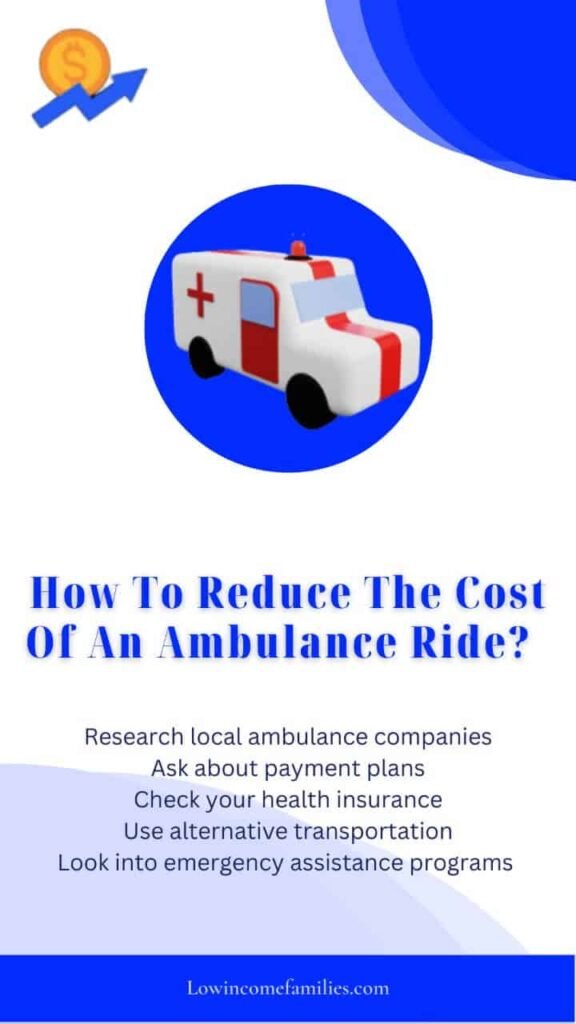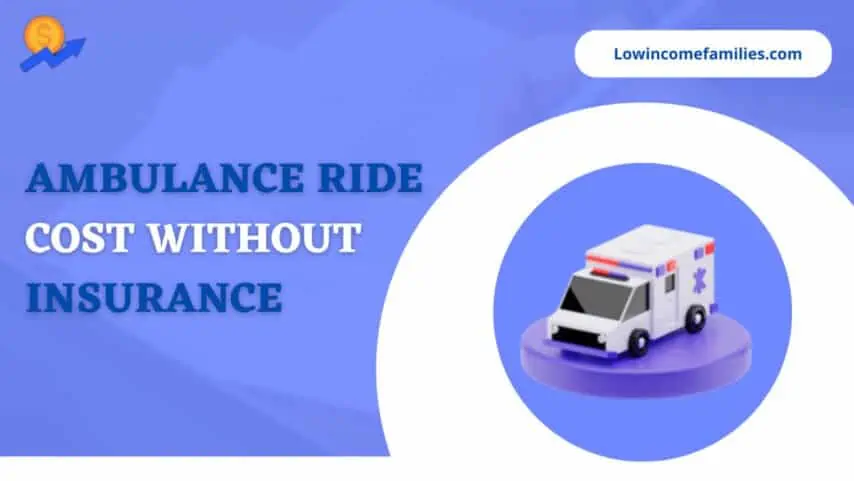In this blog post, we’ll explore ambulance ride cost without insurance, and provide some tips to help you save money. An ambulance ride can be a lifesaver in an emergency, but it can also be an expensive one.
The cost of an ambulance ride without insurance can range from hundreds to thousands of dollars, and it’s important to understand what you may be liable for if you find yourself in an emergency.
In this blog post, we’ll discuss the cost of an ambulance ride without insurance, how it’s calculated, and what you can do to avoid overpaying.
Ambulance Ride Cost Without Insurance
If you ever find yourself in need of an ambulance ride, it’s important to know how much it could cost. Ambulance costs can vary drastically depending on your location, the level of care you require, and if you have insurance. On average, an ambulance ride without insurance can cost anywhere from $500 to $3,000.
How much you will pay for an ambulance ride also depends on the type of service provided. Basic Life Support (BLS) is typically less expensive than Advanced Life Support (ALS), which includes paramedics and more sophisticated medical equipment.
Depending on the severity of the situation, you may end up paying more for an ALS ambulance ride. Other fees that may apply include mileage charges, additional personnel costs, and equipment fees.
Keep in mind that these charges can vary significantly depending on the services needed and the distance traveled. Finally, it’s important to note that in some states, you could be charged a fee even if you don’t use the ambulance or receive medical treatment.
So it pays to do some research ahead of time to understand what fees might apply in your area.
Understanding the cost of an ambulance ride is essential so you can plan in case of an emergency.
Fortunately, there are several ways to reduce the cost of an ambulance ride if you don’t have insurance. We’ll discuss this more in the next section.
Must Check: How much is the urgent care cost, if you don’t have insurance?
How Your Location Affects The Cost Of An Ambulance Ride?
In addition to these regional variations in cost, ambulance services may charge extra fees based on the type of care they provide. For instance, if the ambulance service must transport you to a hospital or trauma center instead of a local clinic or urgent care facility, they may charge additional fees.
Therefore, it’s important to know which type of care your location provides so that you can be prepared for potential extra charges. Ultimately, no matter where you live, it’s important to remember that an ambulance ride can be expensive if you don’t have insurance.
Therefore, it’s essential to understand how your location affects the cost of an ambulance ride so that you can be financially prepared in case of an emergency.
The Difference Between Basic Life Support (BLS) And Advanced Life Support (ALS)
The type of medical care you receive in an ambulance ride will determine the cost. Basic Life Support (BLS) ambulances are staffed with at least two people, a driver and an EMT or paramedic.
BLS ambulance services are used to transport patients with non-emergency medical needs or who require basic life support such as monitoring vital signs and providing oxygen. BLS ambulance rides can cost anywhere from $200 to $2,000 depending on the location and services provided.
Advanced Life Support (ALS) ambulances are staffed with at least one person, a driver, and a paramedic. ALS ambulance services are used to transport patients with more serious or critical medical needs or who require advanced life support such as administering medication and performing medical procedures.
The cost of an ALS ambulance ride can be significantly higher than a BLS ambulance ride, ranging from $1,000 to $3,000 or more.
Other Fees You May Incur For An Ambulance Ride
When you need to call an ambulance, you may think the cost of the ride is all you need to worry about. However, you could be hit with additional fees if your ambulance ride is not covered by insurance or Medicare.
These fees can add up quickly and greatly increase the cost of an ambulance ride. One common fee you may incur is for mileage. The average cost for mileage for an ambulance is approximately $15 per mile, although this amount can vary by state.
You may also be charged for advanced medical equipment used in the ambulance, such as a ventilator or heart monitor, or for additional medical personnel. These costs can range from $50-$500 depending on the services used.
Other possible fees include registration fees, oxygen charges, and supplies such as bandages, IVs, and any other materials needed during the ride. All of these fees are usually billed separately and can increase the total cost of your ambulance ride significantly.
Finally, most ambulance companies charge an additional fee if you don’t have insurance or Medicare coverage. This fee is typically a flat rate and can range anywhere from $150 to over $3,000, depending on the location and type of service provided.
In short, many additional fees can quickly add up and significantly increase the cost of your ambulance ride. It’s important to understand all the possible fees you may be charged so that you can budget accordingly and plan for any unexpected expenses.
How To Reduce The Cost Of An Ambulance Ride?
If you’re ever in need of medical transportation, an ambulance ride is often the best and safest option for getting to the hospital. Unfortunately, an ambulance ride can be expensive, especially if you don’t have insurance.

Here are a few ways to reduce the cost of an ambulance ride :-
-
Research Local Ambulance Companies
Do your research and compare prices between local ambulance companies. Most companies will post their fees online, so you can compare and determine which one is the most affordable.
-
Ask About Payment Plans
If you’re unable to pay for the entire bill upfront, ask about payment plans or discounts. Many ambulance companies may be willing to work with you to come up with a payment plan that fits your budget.
-
Check Your Health Insurance
Before you call an ambulance, check with your health insurance provider to see if they cover ambulance rides. Many insurers cover at least part of the cost of an ambulance ride, depending on the situation and the type of insurance you have.
-
Use Alternative Transportation
In some cases, an ambulance ride isn’t necessary. Depending on the severity of your injury or illness, it may be safe and cost-effective to use an alternative form of transportation such as a taxi or Uber.
-
Look Into Emergency Assistance Programs
Emergency assistance programs like Project Access NOW may be able to help you cover the cost of an ambulance ride if you qualify. No one likes to think about needing an ambulance ride without insurance.
But it’s important to be aware of how much it might cost and how you can save money in case of an emergency. By doing research ahead of time and taking advantage of available options, you can significantly reduce the cost of an ambulance ride.
Conclusion :-
An ambulance ride is a necessary service in certain emergencies, but that doesn’t mean it has to be expensive. The average cost of an ambulance ride without insurance varies greatly depending on your location and whether you require BLS or ALS services.
In New York City, for example, the cost of a non-insured ambulance ride ranges from $450 to $3,000. In California, the cost is much lower at $300 to $600. There are also additional fees you may incur for an ambulance ride, such as mileage, so it’s important to factor these into your budget.
Fortunately, there are several ways to reduce the cost of an ambulance ride if you don’t have insurance. You can purchase medical expense insurance, look into discounted rates through your local fire department, or even set up a payment plan with the hospital.
Knowing how much an ambulance ride will cost ahead of time can help you prepare financially and make sure you can get the medical care you need.
Frequently Asked Questions
Is ambulance free in the USA?
Ambulance services in the United States are not free. Depending on your insurance coverage and state laws, you may be required to pay a co-payment, deductible, or full cost for an ambulance ride. In some states, non-emergency rides are more likely to be covered by insurance than emergency transports.
Does it cost money just to call an ambulance?
Generally, there is no cost associated with calling 911 for an ambulance. However, some states or localities may charge a fee for dispatching the ambulance. You should check with your local authorities to determine if this fee applies.
How much is an ambulance ride?
The cost of an ambulance ride can vary greatly, depending on your location, type of service (Basic Life Support or Advanced Life Support), and insurance coverage. Without insurance, an ambulance ride can cost up to $3,000. Average costs can range from $600-$2,000 in the US.
Why is it so expensive to call an ambulance?
Ambulances are equipped with specialized personnel and equipment needed to provide care in a medical emergency. The cost of providing these services and equipment is passed on to the patient who uses the service.
What should you not call for an ambulance?
You should only call 911 for true medical emergencies such as chest pain, difficulty breathing, unconsciousness, serious injury, or life-threatening symptoms. Non-emergency situations such as minor injuries or illnesses that do not require immediate medical attention should not be treated with an ambulance ride.
Is it faster to drive to the hospital or call an ambulance?
In most cases, calling 911 for an ambulance is faster than driving yourself to the hospital. An ambulance has access to priority lanes and can be quickly dispatched to your location. Also, they are staffed with medical personnel who can begin treating you while en route to the hospital.
Why are ambulance wait times so high?
Ambulance wait times vary by region and situation. Factors that affect wait times include how busy the dispatch center is, how many ambulances are available in the area, traffic conditions, and the severity of the patient’s condition. In many cases, wait times can be decreased by providing information about the patient’s condition when you call 911.












